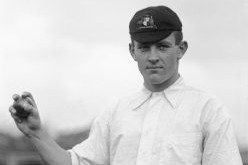By Lyn Collingwood and Ian Stephenson, Bulletin 1/2023, March 2023
As part of a continuing series, this edition of the Bulletin nominates another of Glebe’s historic locations for a ‘Blue Plaque’ – part of a NSW Government program that aims to capture public interest in and fascination with people, events and places that are important to the stories of NSW. The eleventh site nominated for a Blue Plaque by the Glebe Society is Monteith at 266 Glebe Point Road, where the famous cricketer Albert ‘Tibby’ Cotter lived.
Monteith was built in 1891 by John Cotter, a butcher, for his wife Margaret and six sons.

Tibby, the youngest son, was born in 1883 at 132 Phillip Street, Sydney. The Cotters moved to Glebe in 1889. Tibby attended Forest Lodge Superior School and then Sydney Grammar. At Forest Lodge a classmate was the headmaster’s son, Warren Bardsley (1883-1954), who captained the Australian cricket team in 1926.
G.P. Walsh writes in the Australian Dictionary of Biography that Cotter was strikingly handsome and beautifully proportioned; always cheerful and modest, he was generous in his praise of others. Very fast, but often erratic, he had a slinging action and could make the ball lift high from a good length on the plumbest of wickets without recourse to bumping; he could keep his feet on a wet pitch, bowl for long spells and was a good fieldsman. His happy nature and comportment on the field endeared him to all lovers of the game.

He earned his place in the NSW cricket XI at the age of 18 after collecting many wickets for Glebe. He played his first Test against England in 1903/4 and his last in 1911/12 and took 89 wickets in 21 Tests. He was nicknamed ‘Tibby’ because he was small, and ‘Terror Cotter’ for his skill as a bowler. Classed with Harold Larwood for pace, Cotter was one of the fastest of all Australian bowlers. On his first visit to England in 1905 he took 121 wickets with a best Test performance of 7 for 148 at The Oval. His image was used on first world war recruiting posters. He served in the Australian Light Horse and was killed in action at the Battle of Beersheba in 1917, weeks after his brother John was killed in the Third Battle of Ypres. Two other brothers, Arthur Dale (1877–1921), and Edwin (1880–1929) died in railway accidents. William and Norman, the surviving brothers lived at Monteith until the 1950s.










There are no comments yet. Please leave yours.